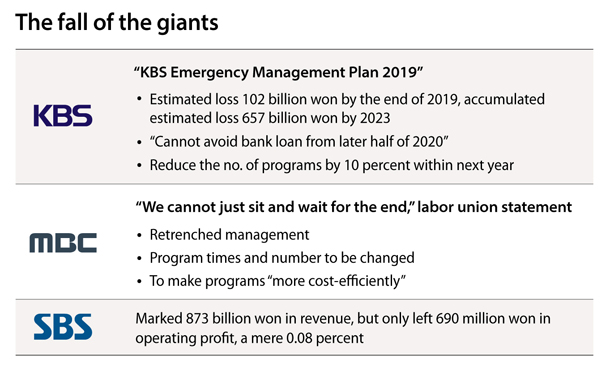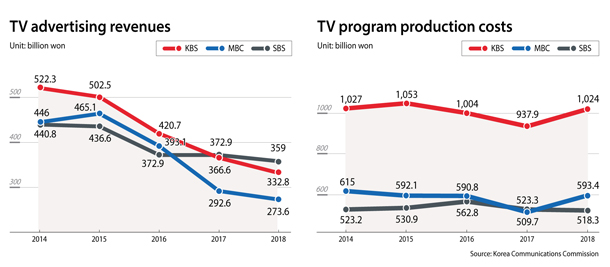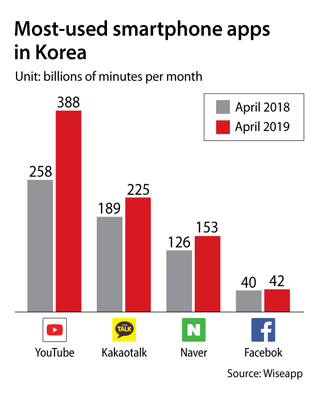New media players send terrestrial TV into crisis: Major networks are caught flat-footed by rise of streaming video

Major terrestrial TV networks are losing viewers to smaller channels and mobile video streaming services such as YouTube and Netflix.
“This is the minimal plan for innovation that we must push through, to overcome the fiscal hardship that KBS faces,” Yang said. “The emergency plan contains a warning to KBS that we could be restructured from the outside if we keep going this way.”
Less than a century ago, the idea of having moving images being transmitted simultaneously across the country was considered a technological revolution that could change people’s lives. There was a time when watching appointment TV was an essential part of one’s daily routine, when the news on TV was considered the primary way to know what’s going on both near and far and when one’s laughs and tears largely depended on which programs were on the air.
Yet, the television behemoths that used to dominate local news and entertainment are struggling to adapt to a new environment that’s changing faster than ever. While the rise of competition from streaming media services like YouTube and Netflix and cable TV networks channels like tvN and JTBC have introduced a diverse range and amount of content never seen before, major TV channels are failing to meet consumers’ tastes that have also diversified with the advent of multiple platforms.
Korea’s first television broadcast system was created in 1956, two years after the first television set was imported into the country. The country’s first television broadcaster, the Daehan Broadcasting Corporation, opened its doors on May 12 in Jongno, central Seoul. Half a century later, in January 2018, there were 407 program-providing businesses registered at the Ministry of Science and ICT and 47 terrestrial broadcasting businesses as of July this year.

MBC’s “Jumong” had a record-high 51.9 percent viewership rating in 2006, while the highest rating this month was KBS’ “Mother of Mine” at 28.6 percent. [MBC, KBS]
In fact, terrestrial networks still enjoy higher viewership ratings than its television competition. For the fourth week of August, from Aug. 19 to Aug. 25, the most viewed show on a terrestrial channel (28.6 percent) was a KBS drama titled “Mother of Mine,” which airs at 7:55 p.m. every weekend, while the cable channel show with the highest ratings, tvN’s new drama series “Hotel Del Luna,” only reached 9.4 percent. The highest viewership rating ever by a cable channel was reached this winter by the JTBC drama series “SKY Castle,” which hit a high of 23.8 percent during its run from Nov. 23, 2018 to Feb. 1 this year.
Despite the ratings, KBS and MBC both felt the need to put emergency plans into action in July. According to KBS’ internal assessment put together by the task force in June, the network estimates a 101.9 billion won loss by the end of the year, which will snowball to 656.9 billion won in aggregate loss by the end of 2023. They “cannot avoid being run on bank loans from the later half of 2020” and must reduce the number of programs that they produce by 10 percent to minimize losses and cut 60 billion won of costs.
“We will make firm choices and concentrate on them, thereby combining similar programs and extending the hours of re-runs,” KBS wrote in its company newsletter.
MBC also recorded a 123.7 billion won loss last year and is said to have already seen a 44.5 billion won loss in the first half of this year. It is similarly aiming to “cut costs by 30 billion won by effectively managing programs” according to the channel. While SBS had a sweet success last year with 872.5 billion won in revenue thanks to major events such as the PyeongChang Winter Olympics and the World Cup in Russia, their operating profit only came in at 689.9 million won - 0.08 percent of the whole revenue.
In fact, advertising sales at the three major terrestrial channels’ have been falling since 2014, according to the Korea Communications Commissions. While all three channels showed a sharp decline from 2014 to 2018, KBS marked the greatest loss, from 522.3 billion won to 332.8 billion won, compared to MBC, which fell from 446 billion won to 273.6 billion won and SBS which fell from 440.8 billion won to 359 billion won.


“Society-media fitness refers to how certain media assumes a major role in society as a result of its fitness to the social environment,” Kim said. “What this means is that there was a time when TVs were the newest technology, when it was in the center of attention and thus the most important [form of] media. Now, we’re in an age and society where other technologies - such as smartphones - have taken over that role. It’s about the interaction between individual medium and the surrounding media ecology.”
But this does not mean that TVs are being replaced by other means, said Kim. It’s rather about dividing a pie that had previously been monopolized by a handful of entities. “We already know by experience that all media can exist. Right now, the problem is that new media are taking parts of the pie, and the whole structure is being reorganized at a faster pace than the pace of the pie growing,” he said.
Professor Lee Sang-woo, a professor at the Graduate School of Information at Yonsei Univeristy, added that terrestrial channels need a major breakthrough at this point to survive the changing environment.

However, figuring out exactly what needs to be done to overcome the current hardship is an ongoing question that experts in the field are actively trying to solve. One such endeavor was made at a seminar held by the Korean Association for Broadcasting & Telecommunications Studies (KABS) on Aug. 23 at the Korean Press Center in central Seoul titled “Reviving the Broadcasting Industry and Strategy on Media Content Foreign Exports.”
“We all know that the broadcasting industry is in dire conditions, but we really don’t have an answer on how to beat it,” said Joo Chung-min, President of KABS and professor of communication at Chonnam National University. “Yet the product of the broadcasters is content. Only with content can we compete in the global market. The only way we can do that is to figure out exactly what our strengths are and focusing on that to maximize profit.”
The best and perhaps the only way for local media to survive against the influx of foreign OTT services - with Disney+ soon to join the already-crowded market, as well as the upcoming launch of Korean OTT wavve - agreed by experts is for Korean media producers to focus on creating better content to lure audiences from both inside and outside Korea.
“This is the time for us to focus on our contents,” said Yu Kon-shik, head of research at the Public Media Institute of KBS. “But honestly, we can’t afford to. KBS and MBC all foresee deficits of 100 billion won, and KBS will stop producing their Monday-Tuesday dramas next year. But if they stop making content, they’ll have less to export and make less money from it. That’s when people are going to start saying that Hallyu is dying.”
BY YOON SO-YEON [yoon.soyeon@joongang.co.kr]










with the Korea JoongAng Daily
To write comments, please log in to one of the accounts.
Standards Board Policy (0/250자)